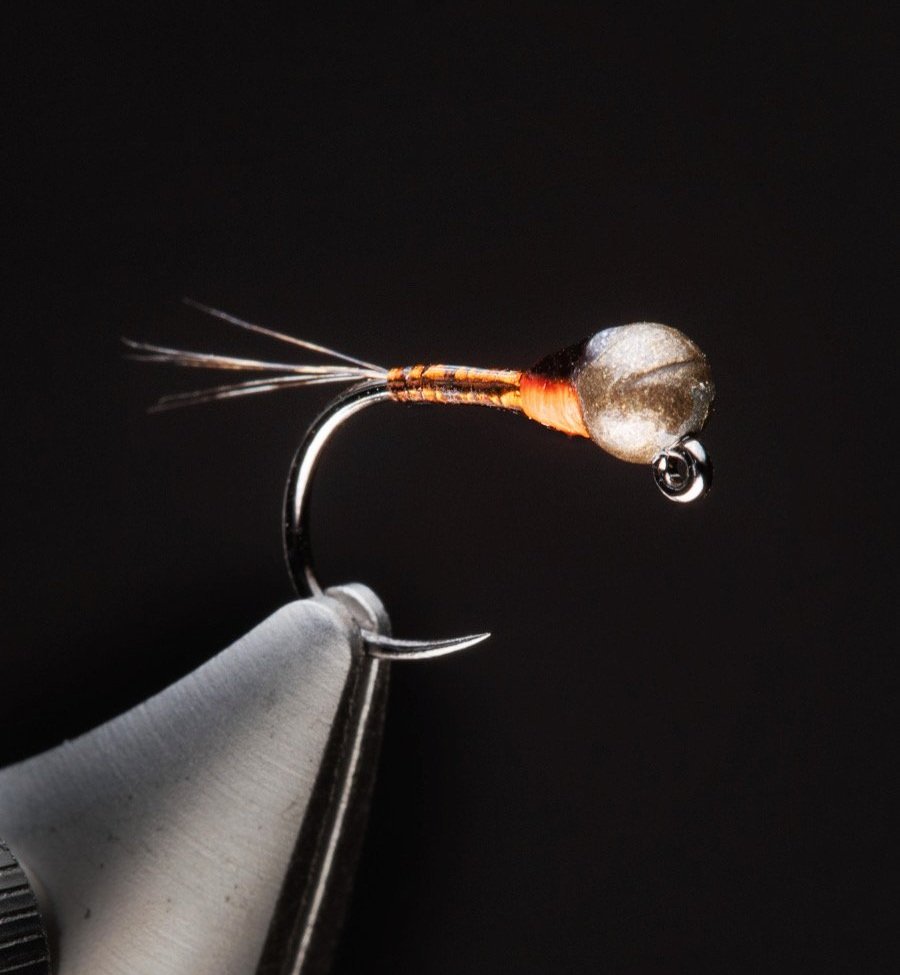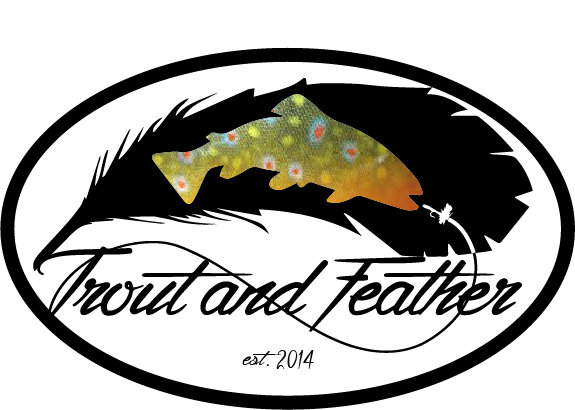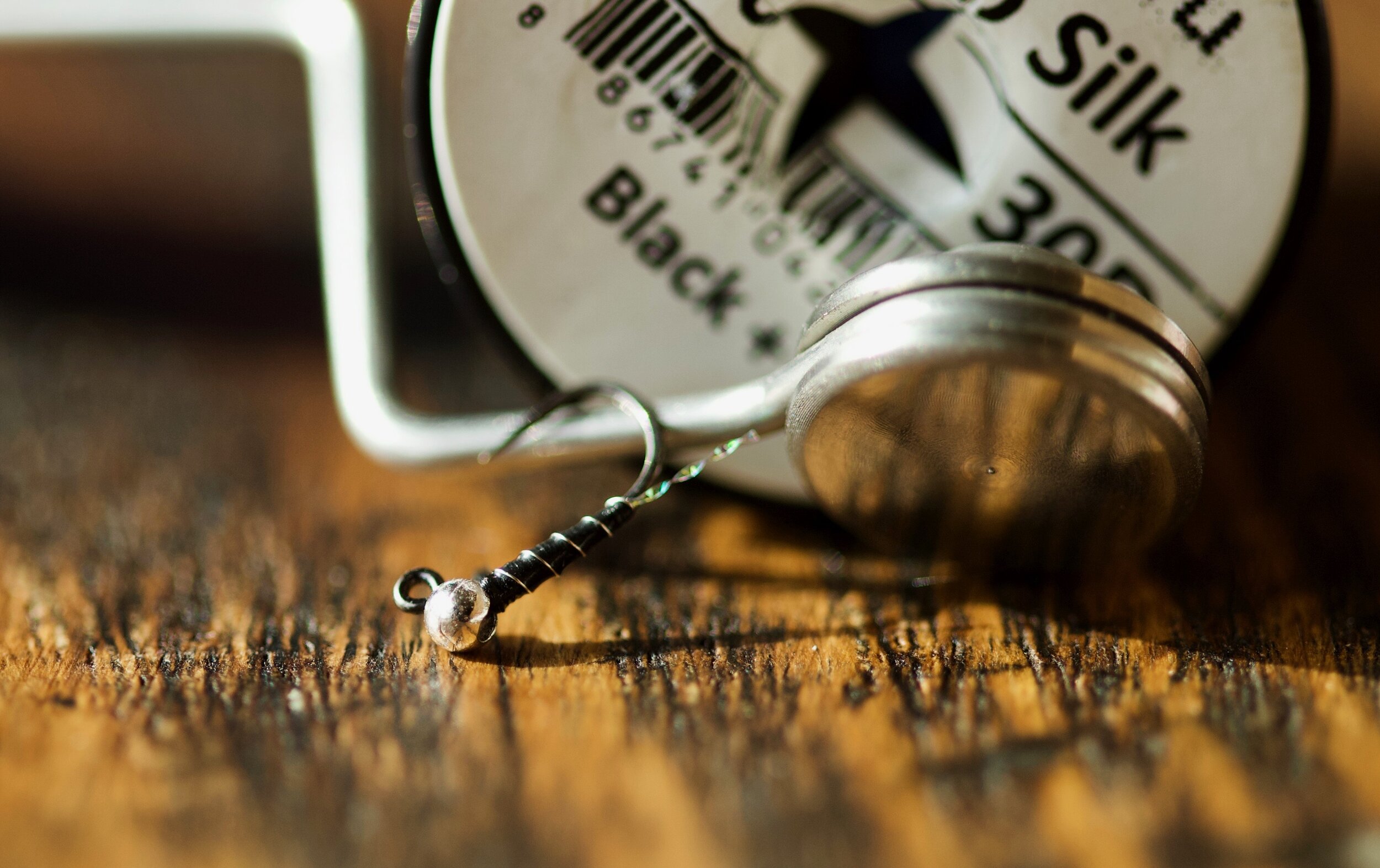Euro Nymphs
Euro nymphs, also referred to as jig nymphs, are a popular style to fish being that they get to the fish quickly due to their typical characteristics: Heavy bead and slender body. Another benefit is the slotted tungsten bead on a jig or down-eye nymph hook, encouraging the fly to ride hook point up. This will cause less snags, so you are not constantly retying these patterns. Finally, I suggest taking some of your favorite nymphs and tie them on jig hooks to see how they perform; I think you'll be excited by the results!
There are many options for Euro nymphs, and you’ll find many favorite on this page. I also have a blog featuring the BEST Euro nymphs to use, click the button to read more:

Egan’s Rainbow Warrior
Created by Fly Fishing Team USA member Lance Egan, the Rainbow Warrior is now being featured on a jig hook. Paired with a slotted tungsten bead, this pattern tends to write hook point up, thereby getting fewer snags.
Look closely at this style of fly, as you’ll see a wide hook gap, slender body and a tight thorax, all characteristics of Euro nymphs. I frequently am asked to compare these with Czech nymphs, with the latter tending to have much more weight in order to nearly drag on the bottom.
Returning to the Rainbow Warrior, Lance designed this fly to be fished in clear tailwater rivers, not what you’d expect from such a flashy pattern. Picky fish love this fly, and many others like it, thus be sure to have some of these in your box at all times!

Perdigon
Talk about a minimalist pattern! Tied with few tail fibers and a slender body, Perdigons are known to cut through the water and get to the desired depth quicly. Some also have hot spots; this one features a fluorescent thread thorax.
Into tying Perdigons? Check some of the videos below. Prefer to buy your flies? Check my friend Devin Olsen’s fly shop for lots of recommended Perdigons: CLICK HERE
Which Perdigon style should you start with? I recommend two versions, one flashy and the other subtle. The fish will tell you which they prefer, and my general rule is:
Fast water = Tinsel-bodied Perdigons are attention grabbers and entice fish to eat.
Slower water = Muted thread=body Perdigons are more realistic, an excellent choice for technical fish.

The Perdigon nymph is a special one that comes to us from competition fly fishing. This fly has a great look, plus the ability to catch both fish and fishermen. In this video, I show you the basics to tying the Perdigon and talk about its use when fly fishing.

Cammisa's Stealth Mode is a jig nymph that pays homage to tinsel-bodied flies with its use of UNI-Mylar. Though that material has "stealth" tendencies, everything completely changes with the rear hot spot...and fish don't seem to mind. Be sure to try this one with a matte black bead! Learn more about this pattern in the video.

Jig nymphs are nothing new to fly fishing, yet I've noticed that many are hesitant to take that initial plunge. During this video, I go over the tying procedures for a generic jig nymph, and then variations to enhance the pattern. Finally, the last section involves a discussion around fishing with this style of fly. As I mentioned in the video, don't be afraid to experiment and show your creativity when selecting materials to tie these nymphs!

The Mop Fly has arrived! In this fly tying tutorial, I share my procedures for tying the pattern, plus talk about how it came to be. There are a variety of places to purchase the "mop material" from, thus be creative in your search, as the greatest variation of this fly (as of now) is changing its color. Have fun with this "guide style" pattern!

If you haven't had enough fun with the original, here comes the Micro Mop! This pattern has an application for many situations, especially those discussed in the video. With many variations and tying methods available for this one, the Micro Mop allows for some creativity, plus it's an overall quick tie.

In this video, Stephen "Big T" Tomasovich is the guest tier, sharing an exceptional Euro nymph, the CDC Micro Bugger. Simple to tie, plus MANY ways to fish this streamer...it belongs in your box! Tie this in a variety of your favorite colors, including peach, olive, and black. Afraid to use CDC on a streamer? Get over that fear, as the fish certainly appreciate it. ;-) Thanks again, Stephen, for sharing this one!

In this fly tying tutorial, I explain the procedures for tying Kevin Compton's Czech jig nymph, the "Ginger Snap." This attractor fly, requiring intermediate tying skills, is tied on a jig hook, in line with other Czech-style and Euro jig nymph patterns. The "Ginger Snap" also utilizes additional great components, such as a dubbing loop thorax and peacock quills for the body. Kevin's brother Bryant, who guides for Vail Valley Anglers uses this pattern on a regular basis, which speaks highly for the pattern.

In this video, I share the "Perfect" Jig Nymph, which is a general Euro nymph tied with Semperfli Perfect Quills for the body. They are an excellent choice, being easy to utilize, plus allow the thread color to show through. Add some CDC and your favorite dubbing to a jig hook...and you're ready to catch some fish TODAY!

Here's a variation of my favorite Landon Mayer pattern, the Mini Jig Leech. With the addition of a jig hook and some Solarez Bone Dry, this pattern is now ready to go! Join me in the video as I tie the Mayer's Mini Jig Leech, interview Rob Giannino from the Fly Fishing Journeys podcast, and discuss fishing Wyoming's North Platte River with Ryan Anderson of Wyoming Fly Fishing. Lots in this one!

In this "Two Minute Fly Tying" tutorial, I share the Eggstasy Egg fly, a simple pattern that fish can't resist under certain conditions. In this video, I share the base pattern, but remember that there are multiple variations out there of this fly.

We welcome guest tier Rich Ferrara to tie one of his most succesful jig nymphs, the Open Wound. Rich is an excellent tier, with patterns being featured in George Daniel's newest book, "Nymph Fishing."

In this fly tying tutorial, I demonstrate the techniques used to tie Lance Egan's Frenchie nymph. This effective pattern has been gaining popularity over the last few years, and with good reason: It catches trout! I offer a number of variations, including tying the fly on a jig hook, which will certainly appeal to many crowds, such as those in Euro or Czech-style nymph fishing and competition anglers.

The Cahill Frenchie is a more representational jig nymph, walking that line between emerger and Euro nymph. Will Light Cahill mayflies be emerging on the stream bottom, where this is fished? Typically not, but the noticeable contrast will catch their attention, leading them to a pattern that consists of "food colors" they've grown accustomed to eating during hatch season. TYING TIP: Have some tied with brass beads, or none at all, and fish those as droppers or in the film, especially when fish are feeding closer to the surface.

Featured in this YouTube fly tying tutorial is a classic pattern with a modern twist: the Prince nymph tied on a jig hook for European- and Czech-syle nymphing. By slightly modifying this fly, we end up with a "Guide Pattern," being that the fly has reduced materials, fewer procedures, and is effective at catching many fish. I recommend this pattern to all, especially if you are interested in European nymphing, including the Czech and French styles.

If you fish in waterways known for caddisflies, here's a pattern that belongs in your fly box! This caddis is one that I fish to imitate the Grannom Caddis (also known in areas as the Mother's Day Caddis). This is a "new and improved" version of a previous video, and I'm sure you'll enjoy this one.

The Walt's Worm is a pattern that has led to MANY variations...and here's another! Join me in this video as I share the Walt's Worm Blowtorch, plus share a story about Mr. Walt Young.

In this "Two Minute Fly Tying" video, I share the modern version of the Utah Killer Bug that I fish. This pattern is incredibly simple to tie, and I give a few tips that may help you out. Thanks to my friend, Tom Glass, for sharing this one with me. Also, shout-outs to Frank Sawyer and the Tenkara Guides! ;-)

A little-known fact about Chuck Furimsky is that he used to be in the leather industry, and he's applied those skills to one of his newer patterns, the Chuck Nymph. This unique fly features a specially-cut leather called Bugskin, which has great action in the water. You will also enjoy the story behind this fly's name...

Being that the Hare's Ear is such a classic and venerable pattern, it's only fitting that applying new styles to it occur more often than not. The Czech-style of nymphing has overtaken many areas of fly fishing, and it's easy to convert the Hare's Ear to that type of a pattern, as shown in the fly tying tutorial. There are many options that you have with this pattern, and I explore a few during the video. I do want to stress that this is a larger pattern (sizes 8-12) and I fish it in fast water, thus you'll notice that I tie this pattern in the "guide style" with few of those options added on.

Featured in this video is the "new and improved" version of the Lightning Bug, slightly revised from my original video. This is the version you'll now find me using, and I hope you enjoy some of the variations I share in the video.

Featured in this fly tying tutorial is a pattern that is popular among the Czech / Euro jig nymphing crowd, Napoleon's Dynamite. This is a fly that features weight, a slender body, and a couple hot spots. Combined with those characteristics are some great colors, and we have a pattern that catches lots of fish. The hot spot can be as a tag or collar, with the former being more effective in areas that receive lots of fishing pressure. Feel free to modify this pattern to meet the needs of your fishing, and I recommend starting by substituting other fluorescent colors.

For this tutorial, I chose a fly that has an extremely traditional look, known as the Bloody Mary. The tying of this nymph includes a few intermediate techniques but is generally a simple and straightforward process. I commonly fish this as an anchor fly, especially when European nymphing.

During this tutorial, I demonstrate a few methods used on a great all-around nymph pattern, the stonefly. This pattern can be fished with many methods, including European / Czech nymphing and when utilizing the hopper-dropper or dry-dropper rigs.

Many flies have been modified over the years, though their "variant" versions rarely outproduce the original. This fly may prove to be that one! Though distinctly different from the original Hare's Ear, this modified Guide's Choice is a killer pattern that can represent different insects at various stages. In this version, the pattern is tied on a jig hook and intended to drift lower in the water column. Definitely experiment with the pattern and determine which color combinations and weights work best for you.

When fishing spring creeks (and other streams with water cress), don't forget about the Cress Bug! This fly is effective in many situations, and I primarily recommend fishing it in the riffles as part of a nymph setup. When tying the Cress Bug, be sure to focus on the key characteristics, as mentioned in the video. Have fun with this one, and definitely get it into your box!

Guest tyer John Mlakar ties a great pattern known as the Swimming Crane Fly Larva and then shares some of his personal variations (which I highly recommend looking into!). John also gives us some tips to fish this fly, which is a simple and effective one. Have fun with the variations of your own, and let us know how you like this Swimming Crane Fly Larva.

This is absolutely a fly that qualifies for my "Two Minute Tying" series! The Squirmy Wormy has that deadly combo of being simple to tie and catching lots of fish. There are certain situations that this fly works better than others, and I discuss those (and some tying variations) in the video.

In this fly tying tutorial, we welcome back guest tier Jake Adamerovich of Competitive Angler. Another variation is shared, this time of his Soft Hackle Perdigon...sans the hackle! Thanks for taking the time to share this with us, Jake.

We welcome back Mr. Kevin Compton of Performance Flies. Kevin shares one of his newer patterns, the Sterling jig nymph, and be sure to stick around immediately following the tying, as he also shares a tip to make your fly tying more efficient. There are lots of intermediate to advanced techniques in this one, thus be prepared to watch it more than once! Thanks for sharing this great fly with us, Kevin.
Improved Zebra Midge
It’s tough to improve a classic, yet this version of the Zebra Midge has done so! Shared with my by Competitive Angler owner Jake Adamerovich, the Improved Zebra Midge adds a hint of sparkle to the tail, plus UV resin to strengthen the overall pattern. Placed on a jig hook with a slotted tungsten bead, this little pattern has the ability to pull some large trout from the depths of both moving and stillwater.
A key for this pattern is to keep the overall profile slender, thus I recommend using a fine diameter thread, such as Semperfli 18/0 Nano Silk. GSP thread is perfect for this application, as there is little build-up…yet it is STRONG and perfect for all levels of tiers.
Euro nymphs come in all sizes, as this one definitely resides on the smaller size in my fly boxes. From a #16 - #22, be sure to vary the colors based on those that work in your local waterways. Black, olive, and red are favorites that I don’t leave home without!

In this video, I share the "BEST" Squirmy Wormy yet! ;-) This version adds Orthodontic Elastics, giving you the ability to quickly insert new Squrimy material once those fish have torn apart your old one. The video ask for your opinion of this technique, and be sure to give insight behind your answer. As always, this is a pattern that catches many species of fish, and we discuss situations and setup for fishing the infamous Squirmy Wormy.

The Sweet 16 is everything that I love about tying Euro nymphs! Slender body, tight thorax, and that PINK bead that draws fish in. Paying homage to my daughter Josephine, be sure to try this fly out in a variety of situations. During the video, I share some tying and fly fishing tips, and please let me know how the Sweet 16 works for you!


Cammisa's Sneak Attack is a fly I've been tying and fishing since 2018, and one in which I've had success. Then again, if you follow me on Instagram (@troutandfeather), you've already seen this fly and some of the trout caught on it. ;-) Keep the tie slender and experiment with the dubbing that works best for you. When fishing this jig nymph, I prefer sizes #14-16 on the point, and smaller sizes as a dropper. Have fun with the Sneak Attack!